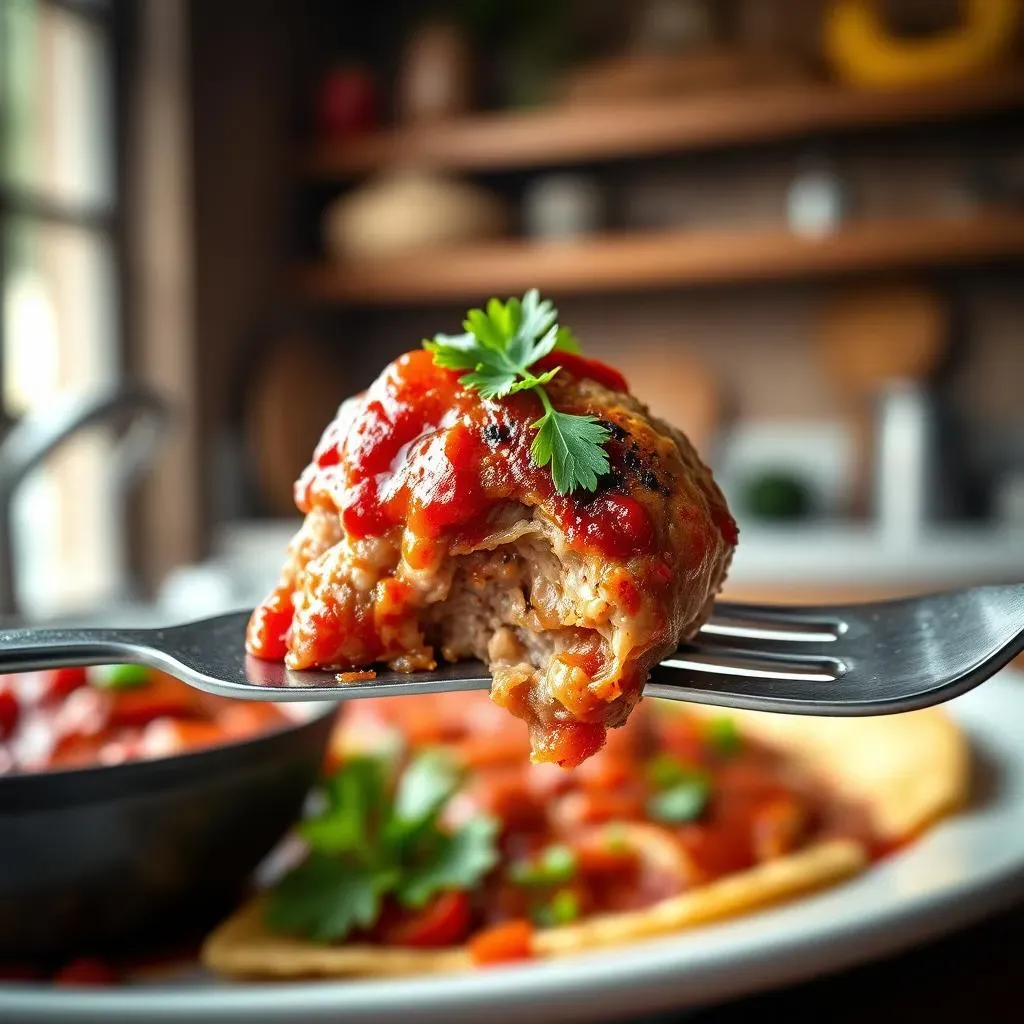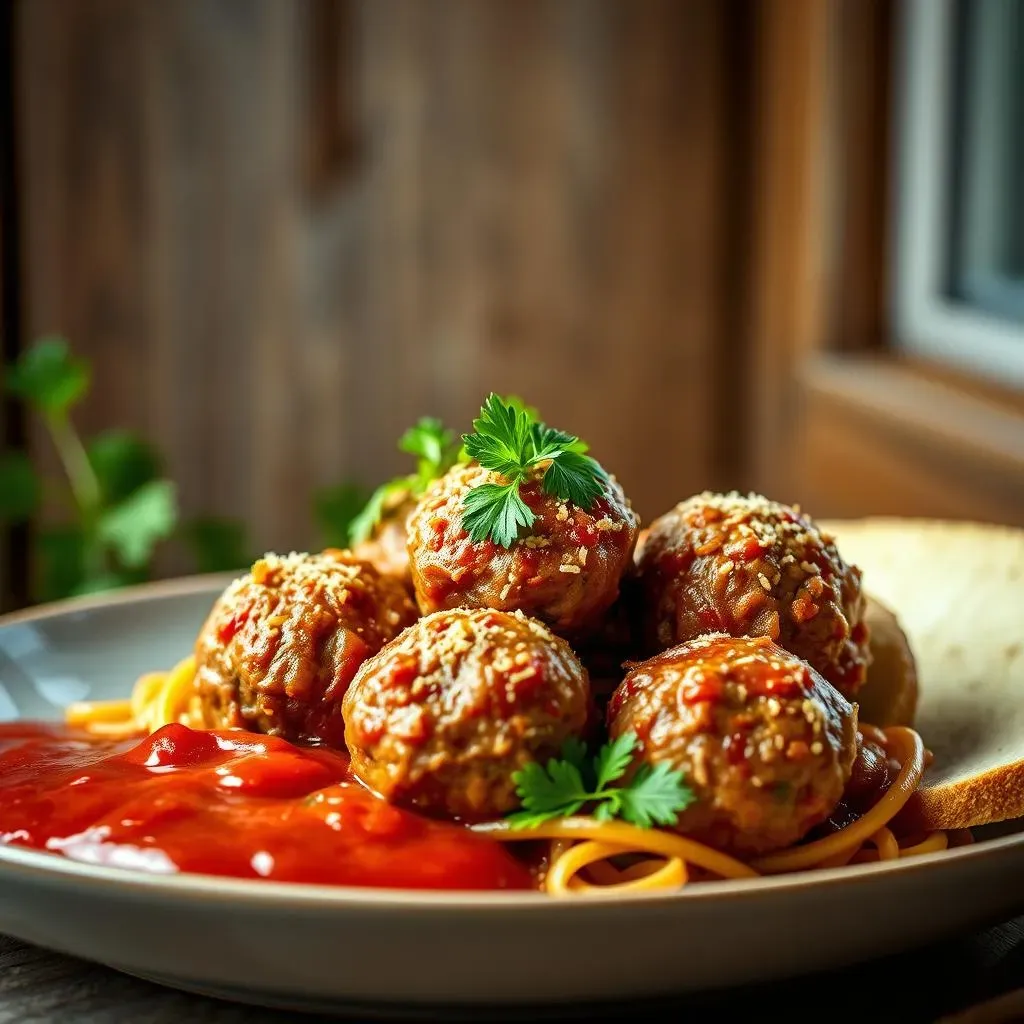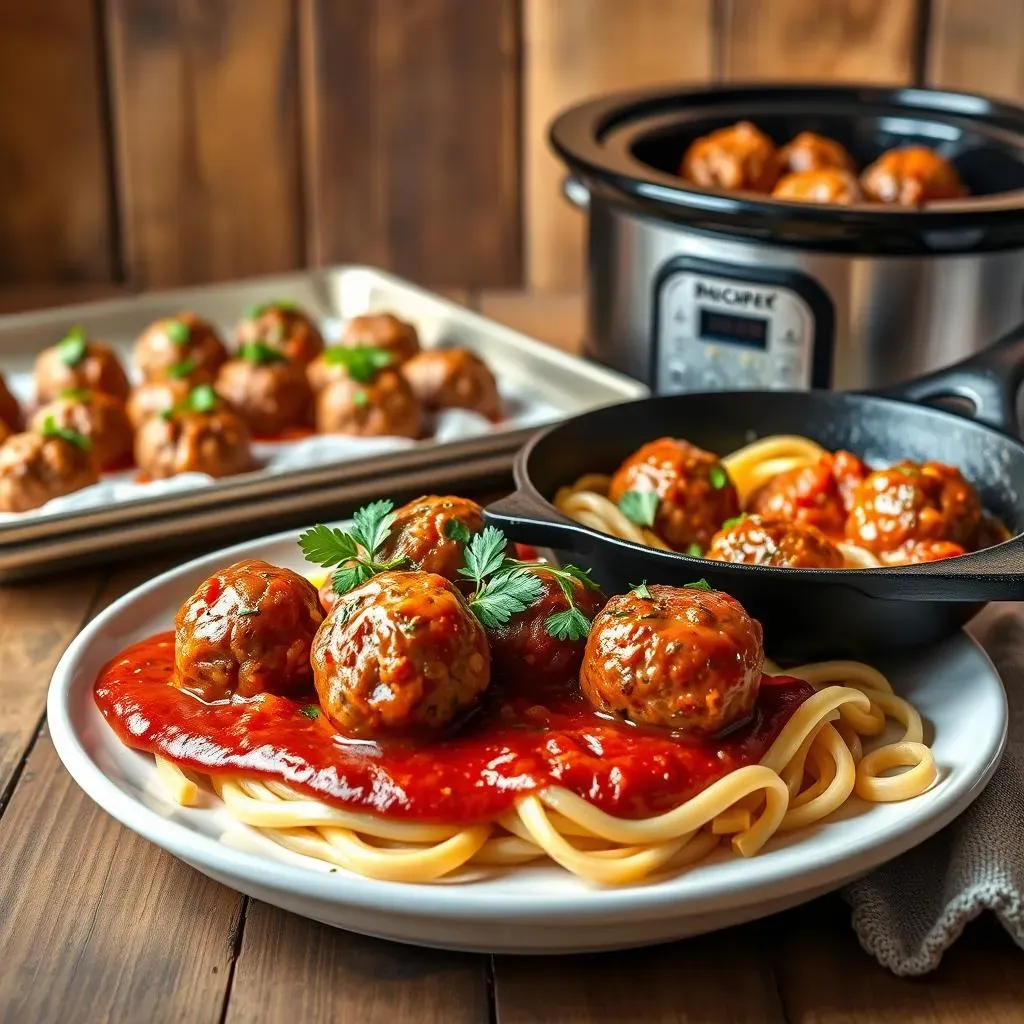Table of Contents
Are you craving juicy, flavorful meatballs but need to avoid gluten? You're in the right place! This comprehensive guide dives into the world of gluten-free beef meatballs, offering a simple, delicious recipe and plenty of expert tips to ensure success. We'll walk you through each step, from selecting the perfect ingredients to mastering different cooking methods. Forget dry, crumbly disappointments – this gluten-free beef meatball recipe is designed to deliver tender, mouthwatering results every time. Whether you're a seasoned cook or a kitchen newbie, this guide will empower you to create restaurant-quality gluten-free meatballs right in your own home. Get ready to impress your family and friends with this versatile dish, perfect for weeknight dinners or special occasions. So, let's get started on your journey to mastering the ultimate gluten-free beef meatball recipe!
A Deliciously Simple GlutenFree Beef Meatball Recipe

A Deliciously Simple GlutenFree Beef Meatball Recipe
Gathering Your Ingredients
Let's start with the star of the show: the ground beef! I recommend using 80/20 ground beef for the perfect balance of flavor and juiciness. Too lean, and your meatballs might dry out. Too fatty, and they'll be greasy. This is a crucial step, so don't skip it! We'll also need gluten-free breadcrumbs (you can find these easily at most grocery stores). If you're feeling adventurous, you can even make your own using gluten-free bread – just pulse it in a food processor until you have fine crumbs. For a richer flavor, consider adding a touch of finely grated Parmesan cheese. Don't forget the egg – it acts as a binder, holding everything together beautifully. Finally, we need some classic Italian seasonings: garlic powder, onion powder, oregano, and basil. A pinch of salt and pepper rounds things out.
Now, let's talk about substitutions. If you're watching your sodium intake, you can easily reduce the amount of salt or use a salt substitute. Don't have Parmesan cheese? No problem! You can omit it entirely or try nutritional yeast for a cheesy, savory flavor. Not a fan of basil? Experiment with other herbs like parsley or thyme. The beauty of cooking is that you get to personalize it! You can also experiment with different types of ground beef. For example, you could try a beef-only meatball recipe for a pure beef flavor.
Ingredient | Quantity | Substitution |
|---|---|---|
Ground Beef (80/20) | 1 lb | Ground Turkey or Chicken |
Gluten-Free Breadcrumbs | 1/2 cup | Almond Flour, Crushed Gluten-Free Crackers |
Egg | 1 large | Flax egg (1 tbsp flaxseed meal + 3 tbsp water) |
Mixing and Shaping Your Meatballs
In a large bowl, gently combine the ground beef, gluten-free breadcrumbs, egg, Parmesan cheese (if using), garlic powder, onion powder, oregano, basil, salt, and pepper. Don't overmix! Overmixing can result in tough meatballs. Just gently combine the ingredients until everything is just barely incorporated. Imagine you're making a delicate meatball soufflé, not a concrete block. This is key to achieving that tender, melt-in-your-mouth texture we're aiming for. Once everything is mixed, roll the mixture into 1-inch meatballs. Try to make them as uniform in size as possible for even cooking. I find it helpful to use a small cookie scoop to ensure consistency. This also helps to keep your hands relatively clean, which is a win-win in my book.
Once you've rolled your meatballs, you can either bake, pan-fry, or slow cook them. I prefer baking because it's the easiest and least messy method. However, pan-frying gives you a nice crispy exterior, and slow cooking creates incredibly tender meatballs. No matter which method you choose, make sure to give your meatballs enough space on the cooking surface to prevent them from steaming instead of browning. You can find more information on cooking methods in the next section. If you're short on time, you might want to check out our 30-minute gluten-free meatballs recipe for a quick and easy option.
- Gently mix ingredients
- Roll into 1-inch meatballs
- Ensure even spacing for cooking
Baking Your Gluten-Free Meatball Masterpieces
Preheat your oven to 375°F (190°C). Line a baking sheet with parchment paper for easy cleanup. Arrange the meatballs in a single layer, leaving some space between each one. Bake for 20-25 minutes, or until the meatballs are cooked through and lightly browned. Use a meat thermometer to ensure they reach an internal temperature of 160°F (71°C). This is the most important part – undercooked meatballs are a definite no-no. Once cooked, remove the meatballs from the oven and let them rest for a few minutes before serving. Serve them with your favorite sauce – marinara, pesto, or even a creamy mushroom sauce would be delicious. You can also add them to pasta dishes, salads, or even serve them as appetizers with toothpicks.
One thing I love about this recipe is its versatility. You can easily adapt it to your taste preferences. For instance, if you want spicier meatballs, add a pinch of red pepper flakes to the mixture. For a richer flavor, try adding a tablespoon of Worcestershire sauce. And if you're feeling extra creative, try adding some chopped vegetables, such as finely diced onions or carrots, to the meatball mixture. The possibilities are endless! For more ideas on how to serve your gluten-free beef meatballs, take a look at our beef meatball pasta bake recipe for inspiration. Alternatively, you could try freezing your meatballs for later use. Our guide on freezing beef meatballs provides helpful tips and tricks.
Ingredient Swaps: Mastering GlutenFree Meatball Magic

Ingredient Swaps: Mastering GlutenFree Meatball Magic
So, you've got your basic gluten-free beef meatball recipe down. But what if you want to shake things up? That's where the fun begins! Ingredient swaps are your secret weapon for creating unique flavor profiles and catering to dietary needs. Let's explore some exciting possibilities. First, consider the ground meat. While we've used 80/20 ground beef, you can easily substitute ground turkey or even chicken for a leaner option. Just remember that leaner meats might require a little extra binder (like an extra egg or a tablespoon of gluten-free breadcrumbs) to prevent dryness. For a truly unique twist, check out our recipe for Chinese-style beef meatballs!
Now let's talk breadcrumbs. While gluten-free breadcrumbs are readily available, you can get creative. Almond flour adds a lovely nutty note, while crushed gluten-free crackers provide a satisfying crunch. Experiment with different types of crackers – even crushed pork rinds can work in a pinch! If you're aiming for a grain-free option, these alternatives are perfect. Want to explore more options? Our recipe without breadcrumbs might be just what you're looking for.
Ingredient | Gluten-Free Swap | Flavor Profile |
|---|---|---|
Ground Beef | Ground Turkey | Leaner, milder flavor |
Gluten-Free Breadcrumbs | Almond Flour | Nutty, slightly sweet |
Parmesan Cheese | Nutritional Yeast | Cheesy, savory |
Beyond the main ingredients, consider your seasonings. Don't be afraid to experiment! A dash of red pepper flakes adds a spicy kick, while a tablespoon of Worcestershire sauce lends a savory depth. Fresh herbs like parsley or thyme offer a brighter, more herbaceous flavor compared to the classic oregano and basil. For a completely different flavor profile, try using a different type of ground meat. For example, a blend of ground beef and pork can create a richer, more flavorful meatball. Need some inspiration? Check out our easy beef and pork meatballs recipe.
Remember, the key to successful ingredient swaps is balance. If you're substituting a wet ingredient for a dry one, you might need to adjust the amount of liquid in your recipe to maintain the proper consistency. Similarly, if you're swapping a strongly flavored ingredient for a milder one, you might need to adjust the amount of other seasonings to compensate. Don't be afraid to make small adjustments as you experiment to find your perfect meatball balance. And remember to have fun! Cooking is all about exploration and creativity. After all, the best gluten-free beef meatballs are the ones that taste best *to you*. Looking for more ideas? Explore our collection of ground beef meatballs recipes for endless inspiration!
- Experiment with different ground meats
- Try various gluten-free breadcrumb alternatives
- Adjust seasonings to complement your chosen ingredients
Cooking Your GlutenFree Meatballs: Oven, Slow Cooker, or Skillet?

Cooking Your GlutenFree Meatballs: Oven, Slow Cooker, or Skillet?
Oven Baking: The Classic Approach
Baking your meatballs is a classic method, offering even cooking and minimal cleanup. Preheat your oven to 375°F (190°C). Line a baking sheet with parchment paper for easy cleanup. Arrange the meatballs in a single layer, ensuring adequate spacing between each meatball to allow for even browning. Bake for 20-25 minutes, or until the meatballs are cooked through and lightly browned. Use a meat thermometer to check for an internal temperature of 160°F (71°C) for food safety. Let them rest for a few minutes before serving. This method is perfect for a hands-off approach, ideal for busy weeknights.
For a richer, deeper flavor, consider adding a tablespoon of olive oil to the baking sheet before placing the meatballs. The oil will help them brown beautifully and add a touch of extra richness. Alternatively, you can toss the meatballs in a light coating of your favorite sauce before baking for a flavorful glaze. Looking for even more oven-baked inspiration? Check out our beef meatball pasta bake recipe!
Method | Temperature (°F) | Time (minutes) |
|---|---|---|
Oven Baking | 375 | 20-25 |
Slow Cooking: Tenderness Redefined
Slow cooking yields incredibly tender and flavorful meatballs. This method is perfect for infusing the meatballs with the flavors of your chosen sauce. In a slow cooker, combine your meatballs with your favorite sauce (marinara, BBQ, or even a creamy tomato sauce). Cook on low for 4-6 hours, or on high for 2-3 hours, until the meatballs are cooked through and the sauce has thickened. The long, slow cooking process allows the flavors to meld beautifully, resulting in incredibly tender and juicy meatballs. This method is especially great for larger batches or meal prepping.
Remember, the liquid in your sauce will help keep the meatballs moist during the long cooking time. However, if you're using a thicker sauce, you might need to add a little extra liquid (like broth or water) to prevent the meatballs from drying out. For a unique twist, try experimenting with different sauces! Our beef stroganoff with meatballs recipe is a delicious example of how to use this cooking method to create a flavorful and satisfying meal. Want to know more about reheating your meatballs? Check out our guide on reheating beef meatballs.
- Low setting: 4-6 hours
- High setting: 2-3 hours
- Ensure sufficient liquid in the sauce
Beyond the Basics: Creative GlutenFree Meatball Adventures

Beyond the Basics: Creative GlutenFree Meatball Adventures
Global Flavor Fusion
Let's take our gluten-free beef meatballs on a culinary adventure! Forget boring marinara; think global flavors. Imagine a vibrant Moroccan tagine, where tender meatballs simmer in fragrant spices like cumin, coriander, and turmeric, alongside apricots and raisins. Or perhaps a zesty Greek lemon-herb sauce, bright and refreshing with a hint of oregano and a squeeze of fresh lemon. The possibilities are endless!
Don't be afraid to experiment with different cuisines. A spicy Asian-inspired sauce with soy sauce, ginger, and garlic would be a delicious twist. Or, for something completely different, try a creamy peanut sauce for a unique and satisfying meatball experience. For some inspiration, check out our Chinese-style beef meatballs recipe to see how easily you can adapt your meatballs to new flavors.
Cuisine | Sauce Inspiration | Key Spices |
|---|---|---|
Moroccan | Tagine | Cumin, coriander, turmeric |
Greek | Lemon-herb | Oregano, lemon zest |
Asian | Soy-ginger | Soy sauce, ginger, garlic |
Meatball Makeovers: Texture and Presentation
Let's move beyond the classic round meatball. Experiment with different shapes and sizes! Try making smaller meatballs for appetizers or larger ones for a hearty main course. You could even flatten the meatball mixture into patties for a fun twist on a classic meatball sub. For a unique texture, consider adding finely chopped vegetables, such as mushrooms, zucchini, or bell peppers, directly into the meatball mixture. This will not only add flavor but also create a more interesting texture.
Presentation matters! Don't just plop your meatballs onto a plate. Get creative! Skewer them with cherry tomatoes and basil for a visually appealing appetizer. Nestle them in a bed of creamy polenta or serve them atop a bed of fresh greens with a vibrant vinaigrette. For a complete meal, try serving them over a bed of your favorite gluten-free pasta. Check out our beef meatball pasta bake recipe for some inspiration. Looking for a quick and easy recipe? Try our easy beef meatball recipe.
- Experiment with different shapes and sizes
- Add finely chopped vegetables for texture
- Get creative with presentation